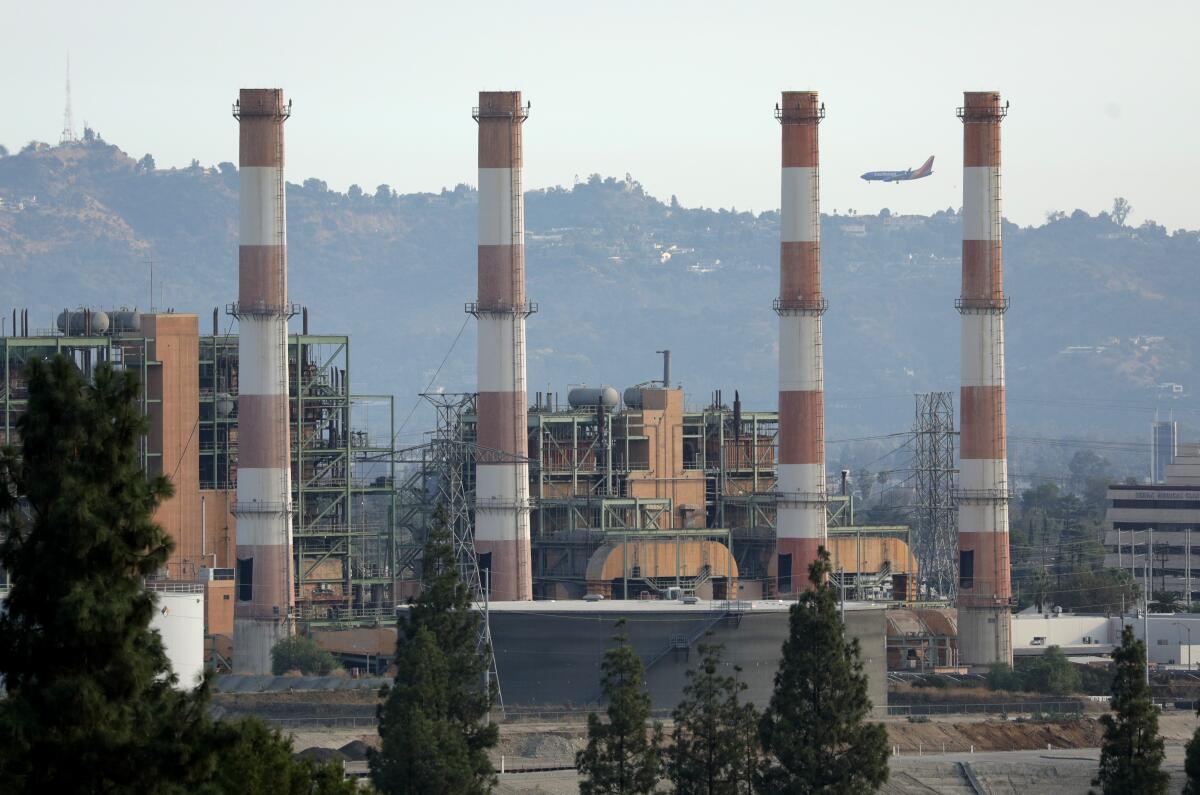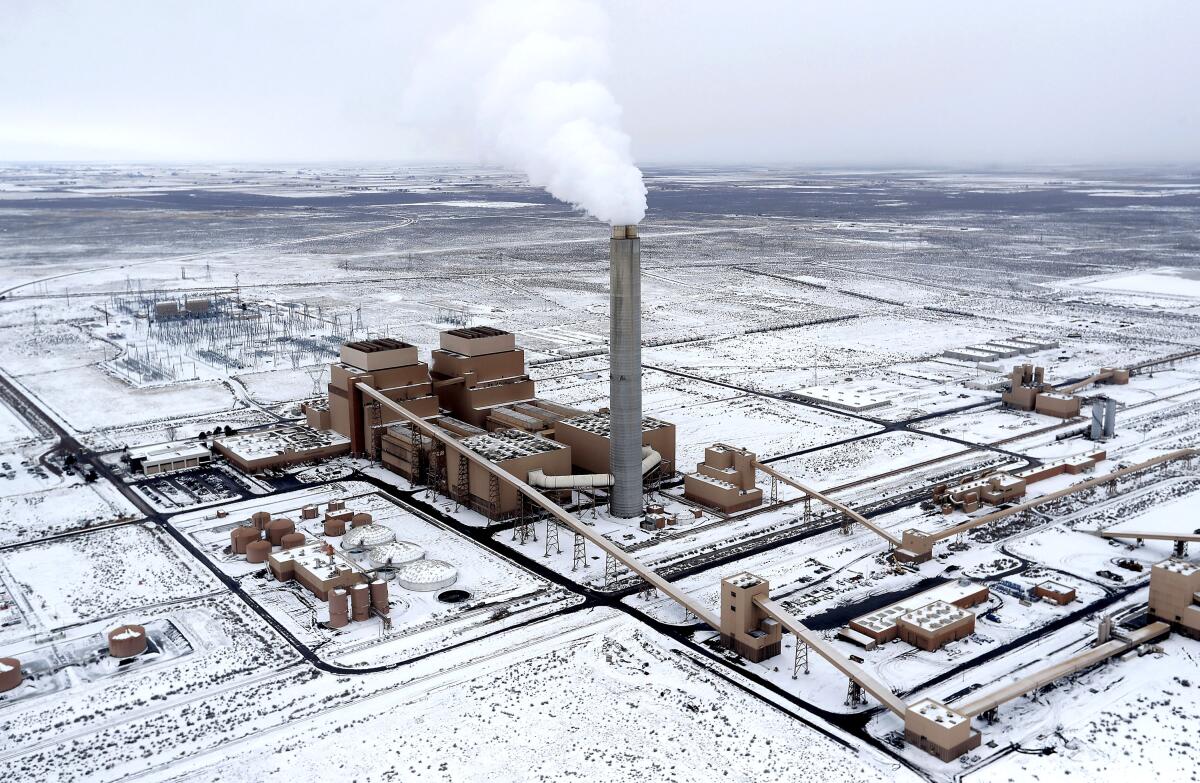Boiling Point: California won’t need to kill fossil fuel plants. They’re dying of old age
- Share via
I haven’t ventured out of my apartment for too much on-the-ground reporting since the pandemic began. But when I heard that a gas plant owned and operated by the city of Los Angeles had been leaking methane for at least three years — polluting a largely Latino, low-income community — I knew I had to go take a look.
It turned out the Los Angeles Department of Water and Power knew about the leak at Valley Generating Station for a full year. But the utility only notified the public after independent scientists discovered the problem and prepared to go public.
Understandably, people living near the plant were furious. Here’s my story on the methane leak, and why it matters from both a climate change and an environmental justice perspective.
“For Black folks, it’s police kneeling on their necks. For a community like Sun Valley, it’s poisoning you slowly for 75 years,” local activist Andres Ramirez told me.

DWP disputes that the leak posed a public health threat. But the story got me thinking about California’s push for 100% climate-friendly energy. Local activists are calling for Valley Generating Station to be shut down, but city officials say the facility will still be needed to keep the lights on during the long-term transition to renewable power — as evidenced last month, when Valley helped L.A. weather a heat storm that led to rolling blackouts in other parts of the state.
There are lots of complicated technical details to be worked out on the road to 100% clean energy. But I was fascinated to learn that one potentially serious obstacle may not be much of a problem at all.
Toward a more sustainable California
Get Boiling Point, our newsletter exploring climate change, energy and the environment, and become part of the conversation — and the solution.
You may occasionally receive promotional content from the Los Angeles Times.
The hurdle involves fossil fueled power plants, and whether ratepayers will get stuck with the costs of paying for plants that are forced to retire before their debt is paid off. Clean energy skeptics sometimes argue that utility ratepayers — meaning you and I and anyone else who doesn’t live off the grid — will bear the burden of paying to shut down these plants early.
But at least in California, so-called “stranded assets” shouldn’t be a significant issue, according to a new study led by Georgia Tech social scientist and engineer Emily Grubert, who analyzed all power plants owned or utilized by California electric utilities.
The study — which was published this month in the journal Environmental Research Letters — estimated when all those power plants are likely to retire, based on historical data for different types of electricity-generating technology. That’s an imperfect but reasonable proxy for the year by which investors will make back whatever money they invested to get the plants built.
Then Grubert and her co-authors estimated what electricity sources are likely to replace the retiring plants, based on California’s steepening requirements for renewable power. Finally, they projected the planet-warming emissions for each utility over time.
Here’s what they found:
The squiggly lines show emissions falling for the five largest utilities from 2018 through 2050, with the rest of the state’s electricity providers clumped together as “other utility.”
You’ll notice the squiggly line for the Los Angeles Department of Water and Power (LADWP) starts out a lot higher than the others, then drops dramatically in the mid-2020s. That’s because DWP currently operates the last coal plant that produces electricity for Californians. It’s located in rural Utah and is scheduled to close in 2025.
The bigger-picture lesson is that all the squiggly lines get pretty close to zero by the late 2030s. That’s important because it reflects an encouraging reality: All fossil fuel plants currently owned by California utilities are likely to reach the end of their expected useful lives by 2045, which happens to be the state’s target date for 100% clean energy.
Also important, most of the independently owned “merchant” power plants in California will reach the end of their typical lifespans by 2045, too.
Here’s a chart showing “committed” carbon dioxide emissions from generators currently serving the Golden State:
See? Nearly all the planet-warming pollution is gone by 2045, just by virtue of fossil fuel plants dying of old age.
Grubert told me she expected her model to show a lot more “stranded assets,” or power plants with debt unlikely to be paid off by 2045. But after decades of policies to promote renewable energy, the state has built hardly any coal or gas plants recently.
So Californians can rest easy knowing they shouldn’t be on the hook for gigantic bills to retire fossil generators early.
“The way people talk about it makes it seem like this massive, massive issue,” Grubert told me. “As long as you don’t build more, you’re not that far off.”
It’s an important lesson for other states, too, since modern gas turbines typically have an expected life of 30 years. So zeroing out carbon emissions by midcentury, which scientists say is necessary to avoid the worst impacts of climate change, shouldn’t require too much “stranding” — as long as power companies stop building new gas plants. (Of course, utilities across much of the country are doing the opposite.)
As far as I’m aware, there’s only one California utility still planning to build a new gas plant, and that’s the Los Angeles Department of Water and Power. The utility intends to build a gas plant in rural Utah, to replace the coal-fired Intermountain Power Plant.
What is going on, you might ask? DWP says its gas plant will eventually transition to clean-burning hydrogen. It’s a wildly ambitious plan, and it could be a boon to the clean energy transition if Los Angeles can prove out the concept, as I wrote last year.
It’s also a risk. If hydrogen doesn’t work out, L.A. ratepayers will be stuck paying for a gas plant with an expected lifespan that runs through 2055. Grubert, for one, is skeptical.
“Owning a brand-new natural gas-fired power plant is not a great move right now,” she said.

The risk could be especially great if California speeds up its 100% clean energy target date from 2045, an idea floated by Gov. Gavin Newsom this month as climate-influenced wildfires ravaged the state.
That could be a big lift for all sorts of reasons. But one cool thing about Grubert’s model is that it’s easy to plug in different assumptions and see how the economic reality changes. So I asked her to check whether a mandate for 100% clean energy by 2035 — the goal endorsed by Joe Biden — would strand a giant amount of fossil fuel assets in California.
The answer? Not really. Even if the state speeds up its clean energy transition by a decade, only about 15% of its current installed power capacity would be stranded. And most of those plants would likely be just a few years away from outliving their usefulness, meaning the economic and policy implications wouldn’t be too serious.
“Closing stuff down five years early is probably not the same level of response required as closing stuff down 30 years early,” Grubert said.
There are some caveats. It’s common for power plants to operate beyond their expected lifespans, although they sometimes shut down early, too.
But overall? This is encouraging news, at a moment in history when all encouraging news is gratefully accepted.
Here’s what else is happening around the West:
TOP STORIES
Last week, I questioned whether Gov. Gavin Newsom would follow through on his pledge of “giant leaps forward” on climate. This week, Newsom made his first move, signing an executive order calling for all new car sales in California to be zero-emission vehicles by 2035, as my colleagues Phil Willon and Tony Barboza report. That would be a seismic and consequential shift. Newsom also called on the state Legislature to send him a bill banning the oil and gas drilling technique known as fracking.
Phasing out the sale of gasoline-powered cars is definitely a huge deal, since transportation accounts for 40% of California’s climate pollution. The Times’ Russ Mitchell has a super helpful explainer on what it means for you. (No, you won’t have to get rid of the oil-fueled vehicle you’ve already got.) Russ also wrote about Volkswagen’s drive to move beyond Dieselgate and become the world leader in electric vehicles, and about Tesla CEO Elon Musk’s plans for a “million-mile battery.”
Many climate advocates cheered Newsom’s announcements, although other said his actions on fossil fuel production aren’t nearly enough. The Center for Biological Diversity is still threatening to sue Newsom if he doesn’t stop issuing permits for new oil and gas drilling, as Phil Willon reported earlier this week. Activists also want Newsom to mandate health and safety buffer zones around oil and gas wells — a step Ventura County is now taking, as Kathleen Wilson reports for the Ventura County Star.
Speaking of oil and gas, two great investigations caught my attention this week. One was this piece by the Desert Sun’s Janet Wilson and ProPublica’s Lylla Younes, finding that California regulators are letting oil companies make millions of dollars in profits from illegal spills that can last years or decades. The other piece, by Mya Frazier for Bloomberg, extensively details how California lets companies get away with avoiding responsibility for abandoned oil and gas wells, a growing climate menace.
CALIFORNIA BURNING
The Golden State is still burning. Firefighters are making progress on the Bobcat fire in Los Angeles County, as federal officials investigate whether Southern California Edison electrical equipment may have ignited the blaze. Farther east, a 39-year-old firefighter died battling the El Dorado fire. Up north, The Times’ Maria La Ganga documents the utter devastation of Berry Creek, a refuge for retirees. In Oregon, low-income families who fled California’s high rents have nowhere to go after their homes were destroyed, Molly Hennessy-Fiske reports. And with drought conditions expanding across the West, the worst may be yet to come.
How worried should we be about the smoke we’ve been breathing? Unfortunately there’s not much research on the long-term health impacts of inhaling this much wildfire smoke for so long. But what we do know is not encouraging, as my colleagues Tony Barboza and Joseph Serna report. The wealthy, of course, can afford their own solutions; be warned that this piece by Sam Dean — about how clean indoor air is becoming a luxury good marketed by real estate agents — might infuriate you. For those of us not in the luxury home market, The Times’ Ada Tseng wrote about how to make your own indoor air filter on the cheap.
Worsening wildfires are just one way that climate change will force a new American migration. That’s a key takeaway from this terrifying but important story by ProPublica’s Abrahm Lustgarten, who writes that the crises to come “are so widespread and so interrelated that Americans seeking to flee one could well run into another.” Of course, nobody wants to leave a place they love; in California, officials are trying to ensure people living in fire-prone areas can still buy insurance, as Joseph Serna reports.
With millions of acres burning across the West, will Congress finally take significant action on wildfires? Anna M. Phillips and Jennifer Haberkorn from our Washington, D.C. bureau posed that question, and perhaps unsurprisingly concluded that no, even a historic wildfire season like this one is unlikely to break through the gridlock — at least until a new Congress is seated.
ON OUR PUBLIC LANDS AND WATERS
You may have seen an image circulating on social media of a Patagonia clothing tag reading, “Vote the assholes out.” I looked into it, and yes, it’s real; the tag refers to politicians who refuse to act on climate change — including President Trump, the company told me. Here’s my story on how the Trump era has changed the outdoor recreation industry, which has responded to the federal government’s rollback of protections for public lands and waters by getting more political than ever before.
California extended temporary endangered species protections to western Joshua trees, as they study whether the iconic plants should be permanently protected. But in a hard-fought compromise between conservationists and renewable energy developers, officials allowed 15 solar projects to raze Joshua trees in the meantime, as my colleague Louis Sahagun reports.
A proposed seawater desalination plant in Monterey Bay is off the table, at least for now. I told you last week about the environmental justice controversy surrounding the facility; shortly after that, the company asked state officials to delay voting on its proposal, saying it hoped to work through local opposition, per The Times’ Rosanna Xia. Down the coast in Huntington Beach, another vote on another proposed desalination plant was delayed at the last minute, Matt Szabo reports.
VARIOUS OTHER THINGS
Let’s return to wildfires, and to the role of forest management. To everyone yelling about how climate change isn’t the only reason we have destructive fires: Yes, you are correct! California and the federal government absolutely need to do a better job of managing the state’s forests. For more insight, I refer you to Times columnist George Skelton, who wrote about the kernel of truth in President Trump’s mostly absurd wildfire comments, and about a Baja California forest that offers a valuable case study.
You may have heard about the massive explosion that rocked Beirut, when a fire detonated an ammonium nitrate stockpile and killed more than 100 people. Here in Los Angeles, residents of San Pedro have worried for decades that butane tanks being stored near homes by Plains All American Pipeline could spark a similar (if smaller) explosion, as my colleague Emily Alpert Reyes reports. The company says there’s no comparison with Beirut, in part because the chemicals are different.
Why didn’t more people take advantage of L.A.’s cooling centers during the recent heat waves? Emily Alpert Reyes took a shot at answering that question. The short version: “Los Angeles has a slim number of official cooling centers scattered across the vast city — and people are often reluctant to travel far in broiling temperatures. Many homeless people are uneasy about leaving their belongings behind on the street. And some people in need, housed or unhoused, are unaware that the city facilities exist.”
What do you want to know?
When you think about California’s climate future, what comes to mind? What keeps you up at night, and what gives you hope or gets you excited? What do you want to understand, and what should I?
This newsletter is for you, to help you understand how we’re changing our world and what we can do about it, and I want to hear your questions, concerns and ideas. Email me or find me on Twitter.
ONE MORE THING

This isn’t exactly a climate or environment story, but there’s a connection, so I’m sharing it anyway. The Times’ Brady McCollough wrote a powerful and deeply reported piece about the Flint, Mich., high school basketball team trying to prove that great things are still possible in a city reeling from decades of industrial decline and a devastating water crisis.
I’m not much of a basketball fan, but I read all the way through the end. A good story’s a good story.
I’ll be back in your inbox next week. If you enjoyed this newsletter, please consider forwarding it to your friends and colleagues.






